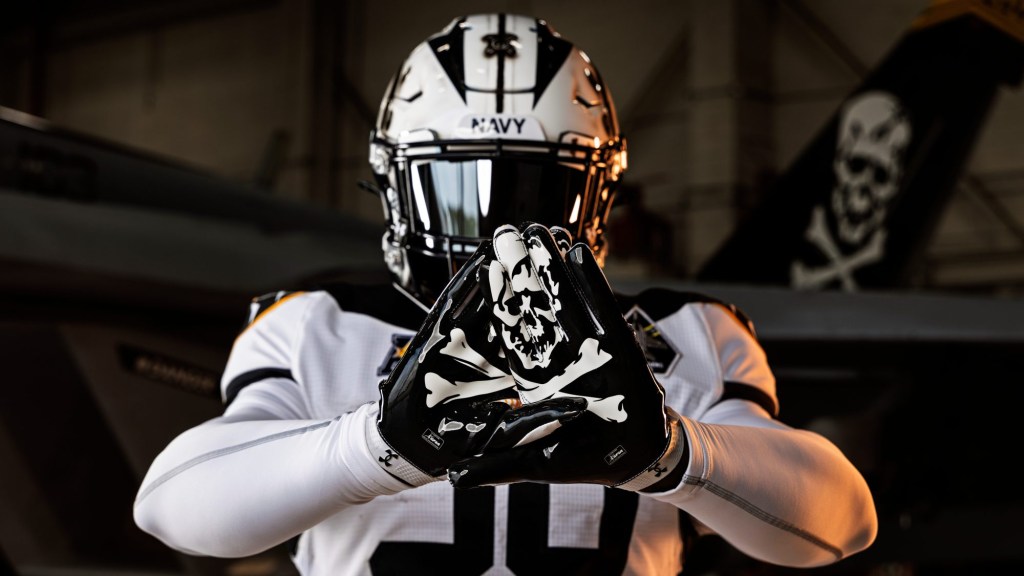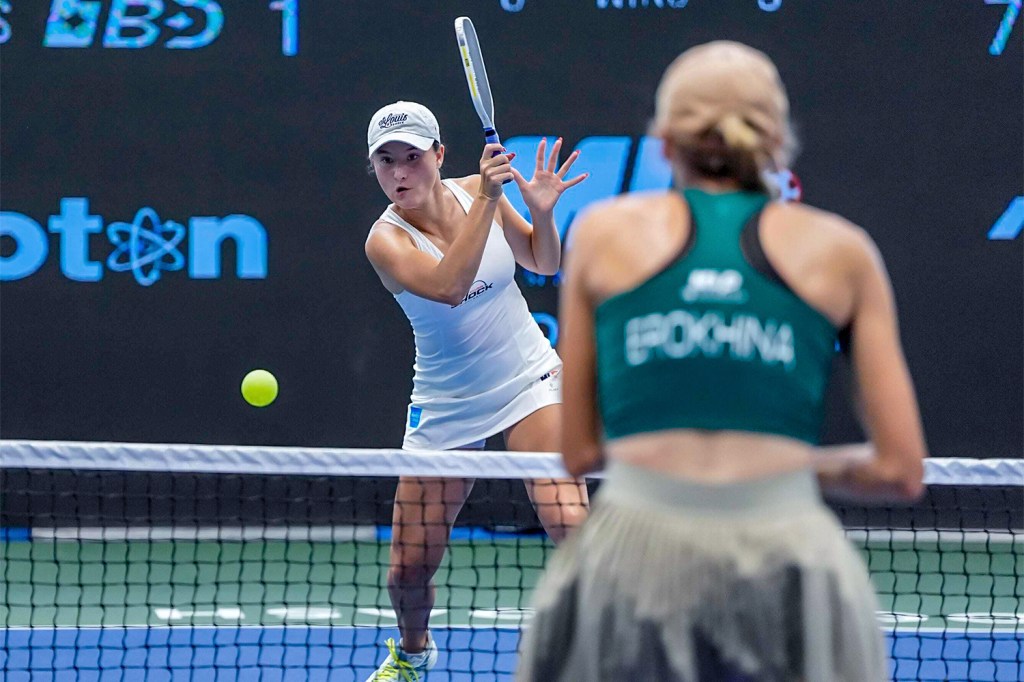On Monday, Nov. 18, the entire student body at the U.S. Military Academy was called into the Eisenhower Hall Theatre on campus at West Point. Before long, the cadets realized this was no normal briefing: The lights dimmed, a machine began billowing smoke, and Army football players took the stage.
It was the annual unveiling of the unique uniform designs for the Army-Navy football game, which will kick off Saturday afternoon at Northwest Stadium in Landover, Md., the home of the Washington Commanders.
“The corps cadets just went absolutely insane,” Army military history professor Lieutenant Colonel (LTC) John Zdeb, who is involved in the uniform creation, tells Front Office Sports. “It was an ear-splitting noise.”
The rivalry, which features two teams with winning records for the first time in years, began in 1890, and has become a 130-year-old mainstay of college football. These days, it’s played the Saturday after conference championship weekend. Even though CBS airs the game, ESPN’s College GameDay has broadcasted its morning show on-site in previous years. Along with cadets and midshipmen, the commander in chief is often in attendance.
The uniform designs have become a tradition of their own. Both programs create jerseys, helmets, equipment, and fan apparel lines honoring military history. The two-year process involves dozens of employees across the academies and their apparel sponsors (Under Armour sponsors the Midshipmen and Nike sponsors the Black Knights), consultations with historians, and even nondisclosure agreements.
This year, the uniforms for No. 19 Army will honor the paratroopers of the 101st Airborne Division and their triumph against the Nazis at Bastogne during the Battle of the Bulge during World War II. (The division is not only famous for its success but also the subject in the 2001 Steven Spielberg series Band of Brothers).
Meanwhile, the U.S. Naval Academy uniforms will honor the Jolly Rogers, a decades-old squadron of fighter pilots considered “the most lethal and history-rich” in the Navy.
“I’ve never worked on anything like that in my 23 years in the army,” says Zdeb, who served multiple tours overseas. “It’s such a distinct honor and responsibility.”
The academies created special uniforms for the first time in 2008, when both were Nike schools. From 2008 to 2013, Nike rolled out new looks, eventually including new cleats and helmets.
“When we were with Nike from 2008 to 2013, we had very little say in what they were trying to accomplish,” Navy senior associate AD for equipment Greg Morgenthaler tells FOS. “They were doing more of what they thought would be the best matchup, because we were both sponsored by Nike. So they would try to tell their own story.”
In 2014, Navy inked a new contract with Under Armour—and that’s when the more academy-focused designs began on both sides. Not every uniform since then has been tied to a specific historical event or military group, but eventually both academies started using the outfits to honor their own histories.

Army and Navy have slightly different processes, but both take about two years from ideation to game day. At West Point, for example, Zdeb heads up a team of four historians who discuss concepts before presenting their final idea to athletic department officials and those at Nike. Zdeb said they decided to focus on the events at Bastogne specifically because they’re less recognizable than oft-celebrated offensives like D-Day.
Then, the apparel companies set to work turning the stories of the soldiers into uniforms, keeping in mind which team has to have light- or dark-colored uniforms each year. They, too, delve into military archives to create the elements of the uniforms—often with the help of the academies themselves.
About a year and a half out from the game, the design concepts are finalized. After the design finalization, “that’s where the NDAs come in,” Zdeb says of Army’s process. “Everyone involved in this project is like, I’m now sitting on pins and needles for a year and a half.”
Navy orders its uniforms a full year in advance. It’s a necessity given that some of the elements, like the hand-painted helmets, take months to create. Meanwhile, in the months leading up to the official uniform unveiling, the schools create webpages and social media strategies for their unveiling.
Zdeb’s team created the website telling the story of the 101st Airborne Division, nicknamed the “Screaming Eagles.” The page briefly introduces the division, complete with photos from the war juxtaposed with photos of the uniforms, maps, and other archival materials. Then, it runs through design elements and how they relate to the 101st and the battle they’ve chosen to honor: the defense of Belgian town Bastogne during the Battle of the Bulge.

The uniform has a dark gray color with white “snow” on the sleeves to depict the “snow-covered pine forests in the Ardennes,” where the 101st dug in and fought during the freezing December of 1944. (Nike found a living member of the 101st who, during a Zoom meeting, kept emphasizing the frigid temperatures, Zdeb said.) Each helmet has a marking corresponding with the different units of paratroopers and gliders in the 101st. The font on the back of the jerseys is made to resemble a typed-out message—to depict when General Anthony McAuliffe responded to a Nazi request to surrender with nothing but the word “NUTS!”
Release day—usually around a month before kickoff—includes not just on-campus activities but also a social media campaign and the opening of online apparel shops. The uniforms fuel the rivalry between the two academies: This year, there was an online debate over which branch of the military could truly claim the icon of the skull and crossbones, which is featured on the Midshipmen’s uniforms but also appears on the Army flag trotted out before games.
But ultimately, the uniforms help honor their alumni and introduce military history to the entire nation.
The Army-Navy uniforms aren’t a moneymaking enterprise. The goal, instead, is to promote the brand on television and social media, while showcasing design capabilities and dedication to their sponsor teams.
“We have always kind of prided ourselves on getting the details right and making that story come to life,” Under Armour senior designer for graphics Adam Dougherty tells FOS.
And they certainly have the resources, given that they don’t have a hard-and-fast budget, according to Dougherty. During a video call with FOS, Dougherty and Under Armour graphic designer for team sports Colby Smith showed the fruits of their labor. Smith presented a PowerPoint of all the elements of the Midshipmen’s uniform—using a model airplane to describe how they relate to the Jolly Rogers’ story.
The palm-side of the gloves show a skull and crossbones—the Jolly Rogers’ insignia—when players hold their hands together. Jersey sleeves sport a stripe similar to the one on the aircraft with nine triangles, each to honor one of the nine different aircraft that the squadron has flown since the 1940s. The team was also given a call-sign (the nickname that pilots use to communicate with one another over the airwaves): victory.
Though not all those details will be visible from the stands—or even on TV—they matter to the players, the academies, and especially to the alums of those squadrons and divisions honored during the game. Smith talked about the value of presenting the designs to a member of the Navy athletic department who had served as a Jolly Rogers pilot.
Says Morgenthaler: “It’s really just a blessing that we’re able to produce a head-to-toe look to make everybody in the Navy and Marine Corps—and all those that serve—proud.”

















